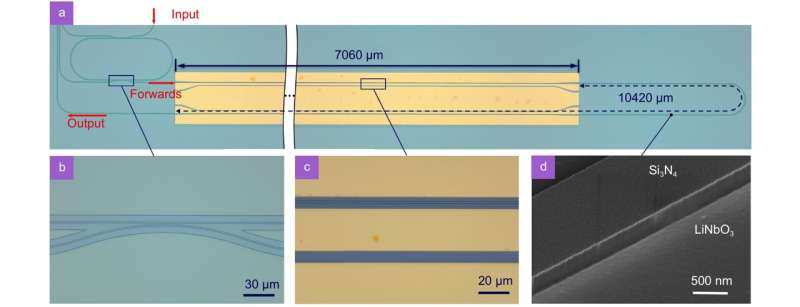This article has been reviewed according to Science X's editorial process and policies. Editors have highlighted the following attributes while ensuring the content's credibility:
fact-checked
proofread
Spatio-temporal isolator in lithium niobate on insulator

Integrated photonics is making strides towards hosting an increasing range of functionalities on a chip. Examples include information processing and computation as well as optical sensing and ranging applications. This has spurred advances in integrated laser light sources, which are needed for photonic chips to become truly autonomous devices. Thus, on-chip isolation likewise becomes important for suppressing feedback detrimental to their operation.
Nonreciprocal optical devices can be realized using three methods: magnetic biasing, optical nonlinearity, and spatiotemporal modulation. Magnetic biasing is inherently broadband but requires lossy magneto-optical materials. Nonlinear non-reciprocal devices are achievable monolithically in certain materials, yet their operation is complicated by dependence on input power. Conversely, isolators that leverage spatiotemporal modulation have no such power scaling issues, and can readily be integrated monolithically, particularly on platforms with excellent electro-optical characteristics, such as lithium niobate on insulator (LNOI).
In this contribution, nonreciprocal operation is achieved by using spatiotemporal modulation of two cascaded traveling wave phase shifters. The microwave signal applied to the modulators and delay line ensures that their effect on forward-propagating light cancels out so that its spectral signature remains unchanged. However, reverse-propagating optical power is spectrally dispersed to the sidebands, which are then suppressed by a ring resonator filter, enabling an optical isolation of 27 dB.
Lithium niobate, due to its broad spectral transparency, high power handling capabilities, and strong nonlinear as well as electro-optic properties, for decades remained a staple material in nonlinear optics and optical fiber communications. The relatively recent emergence of thin-film lithium niobate-on-insulator (LNOI), as a direct analogue of silicon on insulator photonics, has enabled the creation of lithium niobate waveguides with tight mode confinements, that likewise allow for wafer-scale densely integrated photonics.
Recent standout achievements on LNOI include efficient electro-optical frequency combs as well as modulators operating at CMOS voltage levels, however, long term prospects for LNOI photonics are extensive, and include fully integrated LiDAR, optical neural networks, or RF signal processing devices to name a few. Key prerequisites for such developments are emerging techniques of heterogeneous integration of on-chip coherent light sources, which must be isolated from feedback from the rest of the circuit to ensure their stable operation.
To address this issue, the research group of distinguished professor Arnan Mitchell from RMIT university realize integrated isolators in the LNOI waveguide platform. The findings are published in the journal Opto-Electronic Science.
Their device, depicted in the micrograph of Figure 1 (a), was fabricated using a loaded LNOI waveguide approach, in which refractive index contrast for light confinement is achieved not by etching out lithium niobate, but by processing a silicon nitride layer that is deposited on top of the LNOI wafer. The isolator design is based on a tandem modulator approach in which two identical traveling wave phase modulator sections are connected in series and separated by a looping delay line. The modulators are driven at the same harmonic signal frequency but with a shift in phase, so that for forward propagating light the two modulators counteract each other, and the 1550 nm wavelength carrier light exits the device unchanged.
For reverse propagation, this balance set by the delay line and modulating signal phase offset is not valid, hence the action of both modulators in cumulative and spectrally disperses the carrier energy into multiple sidebands. Device input is filtered through a racetrack resonator that is matched to the carrier frequency but designed to reject any modulation-induced spectral sidebands.

Testing the device by injecting the optical carrier in backward and forward directions revealed the non-reciprocal operation of the device. The blue curve in Figure 2 (a) shows the transmission spectrum of the racetrack resonator, which allows optical carriers with the same resonant frequency to pass through. Red curve shows the case when backward light was modulated but without being filtered by racetrack resonator. The original frequency of backward carriers was suppressed, and its power was transferred to sidebands.
Figure 2 (b) shows the backward light was modulated and filtered by racetrack resonator, which means the light was strongly spectrally dispersed and is redirected without being able to pass the ring filter. Figure 2 (c) shows in forward propagation, most of the optical power remains confined in the carrier and only minimal power is transferred to the sidebands. Isolation strength was quantified by measuring the power transmission ratio between forward and reverse operation, resulting in an isolation of 27 dB.
This result is among the highest spatiotemporal modulation-based isolation ratios achieved on any platform to date. The demonstrated suppression of the reverse propagating light makes such isolators suitable for the integration with III-V laser diodes and Erbium doped gain sections in the thin-film lithium niobate on insulator waveguide platform.
More information: Haijin Huang et al, Spatio-temporal isolator in lithium niobate on insulator, Opto-Electronic Science (2023). DOI: 10.29026/oes.2023.220022
Provided by Compuscript Ltd





















